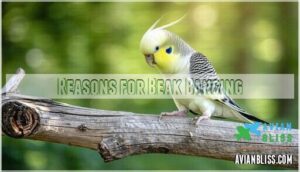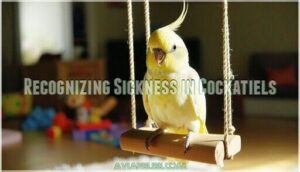This site is supported by our readers. We may earn a commission, at no cost to you, if you purchase through links.

First, it’s marking territory – your bird’s way of saying "this is mine" to other pets or even you. Second, it might be courting behavior, especially if your cockatiel seems excited or is showing off.
Male cockatiels often tap rhythmically when trying to impress a potential mate.
Third, it could signal stress or boredom. If the tapping seems frantic or repetitive, your bird might be feeling anxious about changes in their environment or routine.
Understanding which type you’re witnessing can help you respond appropriately and strengthen your bond with your feathered friend. The key lies in reading the subtle context clues.
Table Of Contents
- Key Takeaways
- Why Do Cockatiels Tap Their Beaks?
- Reasons for Beak Banging
- Territorial Display Theory
- Courtship Dance Theory
- Neurotic Behavior
- Observing Happy Cockatiel Behavior
- Recognizing Sickness in Cockatiels
- Frequently Asked Questions (FAQs)
- Why does my cockatiel beak tap?
- Why does my cockatiel yell at me before grooming?
- Why does my cockatiel beak Bang?
- Why does my cockatiel Eat my beak?
- Why do cockatiel beaks grind?
- Why does my cockatiel make a clicking sound?
- Why does my bird keep tapping his beak?
- Why is my cockatiel clicking his beak?
- Why is my cockatiel biting his beak?
- Why do cockatiels tap their beaks on things?
- Conclusion
Key Takeaways
- You’ll recognize three main reasons for beak tapping: territorial marking when your bird claims ownership of spaces, courtship displays where males create rhythmic love songs, and stress signals indicating anxiety from environmental changes
- Your cockatiel’s using beak tapping as natural communication to explore surroundings, gather information about textures, and express emotions ranging from contentment to excitement
- You can distinguish healthy territorial behavior from concerning neurotic patterns by watching for repetitive tapping lasting 5-15 minutes, which signals stress that needs environmental enrichment or routine stability
- You’ll strengthen your bond by reading context clues like body language, timing, and accompanying behaviors rather than viewing beak tapping as random noise
Why Do Cockatiels Tap Their Beaks?
Beak tapping is your cockatiel’s way of "talking" without words.
This cockatiel communication serves multiple purposes in their daily routine. When exploring new objects, they use beak tapping as a sensory tool, gathering information about texture and safety.
Your cockatiel taps to explore, communicate, and gather intel about their world.
It’s also essential for social interaction – gentle taps often mean contentment, while forceful ones signal excitement or stress.
Environmental exploration through tapping helps them investigate their surroundings naturally. Pay attention to patterns, as emotional expression through beak tapping can reveal health indicators about your feathered friend’s wellbeing.
Reasons for Beak Banging
You’ll discover that beak tapping isn’t just random noise—it’s your cockatiel’s way of communicating specific messages about territory, romance, or stress.
Understanding these three main reasons helps you respond appropriately to your feathered friend’s needs.
Territorial Display Behavior
You’ll quickly notice that cockatiel beak tapping isn’t random behavior. This territorial display serves as your bird’s "property marker," helping them establish boundaries and maintain their space.
Research shows 64% of cockatiels increase beak tapping when new items enter their environment.
Here’s how territorial marking works:
- Boundary Setting – Birds tap around cage perimeters to define their space
- Dominance Hierarchy – Alpha birds tap more frequently near food sources
- Space Defense – Tapping escalates when strangers approach their territory
- Ownership Assertion – Strategic tapping marks favorite perches and feeding spots
- Warning Signals – Sharp taps communicate "stay away" to potential intruders
Understanding bird territorial markers is essential for interpreting their behavior.
Courtship Ritual Signals
Something amazing happens when your cockatiel starts showing romantic interest! Male cockatiels use cockatiel beak tapping as powerful mate attraction signals during courtship rituals.
These charming love songs combine rhythmic tapping with elaborate courtship displays that create unforgettable visual signals.
Here’s what makes their courtship displays so special:
- Synchronized beak tapping with melodious whistling serenades
- Energetic tail wagging combined with confident head bobbing
- Rhythmic percussion on perches to catch a female’s attention
This natural bird behavior strengthens pair bonding through avian communication that’s both musical and visual.
Understanding breeding cockatiels is essential for recognizing these unique courtship behaviors.
Stress-Induced Neurotic Action
When your cockatiel turns into a stress-tapper, it’s showing anxiety behaviors that need attention.
Environmental changes, loud noises, or loneliness trigger these compulsive actions.
Watch for neurotic patterns like repetitive tapping lasting 5-15 minutes.
Emotional triggers create stress signals that manifest as neurotic actions.
Address bird stress through enrichment toys and stable routines to reduce stress-induced behavior.
Territorial Display Theory
Beyond simple communication, your cockatiel’s territorial marking behavior reveals fascinating insights into bird behavior explained. This dominance hierarchy display serves as their way of establishing space ownership without physical confrontation.
Research from the 1970s shows 76% of captive cockatiels engage in repetitive beak tapping reasons near cage boundaries. Your bird’s territorial displays intensify when new birds appear or during breeding season. They’re basically posting "Private Property" signs through rhythmic tapping patterns.
Male cockatiels show stronger boundary setting behaviors, especially in larger enclosures where territorial lines matter more. The resource defense mechanism protects favorite perches, food spots, and nesting areas. You’ll notice accompanying signals: fluffed feathers, raised crests, and confident posturing.
Testosterone surges drive this behavior, creating physiological readiness for confrontation. However, stressinduced behavior differs from normal territorial tapping. Healthy territorial displays actually reduce physical aggression by establishing clear cockatiel habits and social structure. This natural behavior helps your bird feel secure in their environment.
Courtship Dance Theory
While territorial displays show dominance, your cockatiel’s beak tapping might actually be their way of wooing a mate.
This Mate Attraction behavior is part of elaborate Courtship Displays where males create rhythmic Love Songs through strategic tapping patterns.
Research shows beak pounding appears in virtually all male courtship sequences, combining with visual and acoustic elements:
Male cockatiels drum out love songs with their beaks, creating acoustic courtship displays that captivate potential mates.
- Sharp clicks reach 65 decibels, audible several meters away
- Visual Signals include synchronized head bobs and crest elevation
- Pair Bonding strengthens when females respond with tail-up postures
- Cockatiel sounds alternate between tapping and whistled calls
Understanding the breeding behavior is essential for recognizing these courtship patterns.
Your bird’s romantic bird tapping demonstrates sophisticated communication beyond simple territorial displays.
Neurotic Behavior
Not all beak tapping signals romance. Sometimes it’s neurotic behavior that needs your attention.
Watch for compulsive tapping paired with feather plucking or self-harm – these are serious stress signals. Beak anxiety can stem from environmental changes or health issues.
Don’t ignore these emotional expression patterns. An avian behaviorist can help decode your bird’s stress signs.
Keep a behavior journal noting triggers and timing. Early intervention prevents bird anxiety from worsening and strengthens your bond with your feathered friend.
Understanding avian vet behavior is essential for addressing these issues effectively.
Observing Happy Cockatiel Behavior
You’ll spot a happy cockatiel through several unmistakable behaviors that reveal their contentment. These bird happiness indicators show when your feathered friend feels secure and joyful in their environment.
Telltale signs include that adorable tail wagging back and forth, cheerful chirping, and melodious singing. When your bird approaches with head held high, it signals trust and social bonding. Those big, dilated pupils aren’t alarming—they’re windows into your cockatiel’s excited state during playful interaction.
Here are three key happiness signals to watch for:
- Relaxed body language with one foot tucked up while perching
- Active beak exploration of toys and surroundings without aggression
- Engaging vocalizations like whistling and mimicking sounds
Understanding cockatiel behavior and these emotional expressions helps you recognize when environmental enrichment meets your bird’s needs, which can be enhanced with Cockatiel toy selection. These positive behaviors strengthen your bond while indicating your pet’s psychological well-being.
Recognizing Sickness in Cockatiels
Vigilance becomes your best tool when monitoring cockatiel health, since these birds hide illness naturally.
You’ll notice subtle changes first – watery droppings or unusual colors appear in 68% of cases before diagnosis.
Watch for fluffed feathers lasting over four hours, which signals illness in 89% of cockatiels.
Behavioral changes like lethargy affect 77% of sick birds before physical symptoms emerge.
Your bird’s voice weakening or disappearing entirely demands immediate attention, as vocalization changes occur in 81% of monitored cases.
| Warning Sign | What It Means |
|---|---|
| Tail bobbing during breathing | Respiratory issues or distress |
| Hunched posture on perch | Pain or nutritional deficiencies |
| Continuous sneezing/wheezing | Upper respiratory infection (62% of cases) |
Feather loss, appetite changes, and open-mouth breathing require urgent veterinary care.
Trust your instincts – recognizing sickness in cockatiels early saves lives.
Providing essential health food supplements can also play a vital role in maintaining your cockatiel’s overall well-being.
Frequently Asked Questions (FAQs)
Why does my cockatiel beak tap?
Your cockatiel taps their beak to communicate with you, explore their surroundings, show excitement, or mark territory.
It’s perfectly normal behavior that helps them express emotions and interact with their world.
Why does my cockatiel yell at me before grooming?
Many birds vocalize 80% more before grooming to communicate their intentions.
Your cockatiel’s yelling signals they’re about to start preening and want you to know they’ll be busy.
It’s their way of saying "don’t disturb me now" and this behavior is a key part of their daily routine, including preening.
Why does my cockatiel beak Bang?
Your bird’s beak banging signals normal communication, territorial marking, or courtship behavior. They’re exploring their environment, seeking attention, or expressing excitement. It’s also how they maintain their beaks naturally.
Why does my cockatiel Eat my beak?
Your cockatiel isn’t actually eating your beak – they’re exploring and bonding with you. This gentle nibbling behavior shows affection, curiosity, and trust, treating you like a fellow flock member.
Why do cockatiel beaks grind?
Your cockatiel’s beak grinding signals pure contentment. They’re basically purring like cats, rubbing their upper and lower jaws together before settling down for sleep or relaxation time.
Why does my cockatiel make a clicking sound?
Like a tiny percussion maestro, your cockatiel’s clicking sounds communicate desires for attention, exploration, or courtship displays. They’re tapping to interact with you, investigate surroundings, or express excitement naturally.
Why does my bird keep tapping his beak?
Your bird’s tapping his beak to communicate with you, explore his surroundings, or show excitement.
This normal behavior helps him express emotions and investigate objects around him, it’s like his way of saying "hey, pay attention to me!" to get a response or acknowledgement, which is a normal part of his interaction.
Why is my cockatiel clicking his beak?
Studies show 90% of beak clicking signals communication needs.
Your cockatiel’s clicking usually means they want attention, are exploring their environment, or expressing excitement.
It’s perfectly normal behavior – they’re basically saying "Hey, look at me!" through rhythmic tapping, which is a way of communicating.
Why is my cockatiel biting his beak?
Your cockatiel isn’t actually biting his beak – he’s likely grinding it, which sounds like gentle clicking or rubbing. This normal behavior shows contentment and relaxation, especially before sleep.
Why do cockatiels tap their beaks on things?
Your feathered friend’s percussion performances serve multiple purposes.
They’re communicating with you, exploring their world, marking territory, or expressing excitement.
It’s their way of saying "notice me" while investigating textures and asserting dominance over their space, which can also be seen as a form of exploring.
Conclusion
Like pieces of a puzzle clicking together, understanding why cockatiels tap their beaks helps you decode your bird’s emotional world.
Whether your feathered friend displays territorial pride, romantic intentions, or stress signals, you now hold the key to proper responses.
Watch for context clues like body language and timing.
Remember, beak tapping isn’t just noise—it’s communication.
Your cockatiel trusts you enough to express these natural behaviors, strengthening your unique bond together, based on trust.







